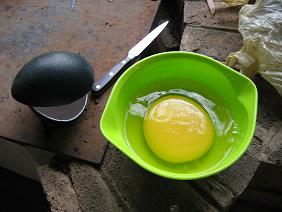 The emus (Dromaius novaehollandiae) on our neighbour’s place are currently laying eggs, in readiness for setting and raising the next batch of chicks. I found a clutch about 1 metre over our boundary fence and mentioned their existence the next day in town to Gaynor (the neighbour) who owns the emus, and was a little surprised when she invited me to take some as they had not yet begun to ‘sit’ on them and it would help her in keeping the number of birds to a reasonable level.
The emus (Dromaius novaehollandiae) on our neighbour’s place are currently laying eggs, in readiness for setting and raising the next batch of chicks. I found a clutch about 1 metre over our boundary fence and mentioned their existence the next day in town to Gaynor (the neighbour) who owns the emus, and was a little surprised when she invited me to take some as they had not yet begun to ‘sit’ on them and it would help her in keeping the number of birds to a reasonable level.I ended up taking 3 eggs (leaving plenty) for the purpose of keeping the shells as ornaments and doing a taste test on at least one of them. The challenge was then to try and neatly halve the shells whilst leaving the yolks intact. After some deliberation I found one way of achieving the goal – purchasing a very fine blade for my 4” angle grinder, marking a straight line around the shell using a rubber band and some chalk, and carefully cutting just through (only) the hard shell and not the soft sack or membrane that surrounds the albumen and yolk. Once this was complete I used a knife to cut through the membrane, placing the HUGE egg contents in a bowl as depicted in the picture. A bit ‘touch-and-go’, but I got there. It was then necessary to remove the white membrane layers on the inside of the shell which was not that difficult. I decided the best way to cook one of the eggs was ‘scrambled’, and added a little milk whilst whisking – the same as for ‘normal’ eggs. This was the daunting part really as the albumen and yolk were so big compared to what I’d usually have a go at - equivalent in volume to about 9 conventional chook eggs.
So “What did it taste like?” I hear you say. It was no different to chook eggs, but the texture was slightly more viscous. Jan and Stuart also shared in the tasting, and there was still plenty left after the 3 of us were fed.
Michael Morcombe’s “Field Guide to Australian Birds” explains that emus are widespread throughout the Australian continent and in the wild tend to live in pairs or family parties of up to 12, averaging 1-2 km apart but much closer when conditions are favourable. They are migratory or nomadic, wandering in response to seasonal conditions and only gather in large numbers due to the existence of man-made barriers such as fences. The species is principally vegetarian but they will take some insects. In the breeding season the females make deep thudding drumming and booming noises; and the males (who sit on the eggs and raise the chicks) give low growls to communicate with the chicks.
No comments:
Post a Comment